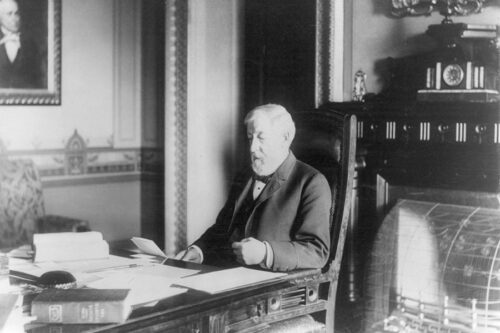
When we talk about providing a strong education for our children, we often focus on empowering parents to make the best choice for their kids. That must always be the bottom line. But when it comes to educational freedom, there’s another choice being debated: whether states should be able to work with private religious organizations to provide more schooling options for parents and children.
The simple answer is yes. States already work with private, religious organizations routinely. Consider faith-based adoption agencies or even religious hospitals. But when it comes to education, there’s even more history at play.
That’s where our case Oklahoma Statewide Charter School Board v. Drummond comes in. When the charter school board (our client in the case) approved an application for a Catholic charter school called St. Isidore of Seville, Oklahoma’s attorney general sued the board. Under state law, religious organizations are prohibited from participating in the charter-school program. At the same time, however, the U.S. Supreme Court has ruled that excluding otherwise-qualified religious organizations from a public program violates the First Amendment. So the school board faced a dilemma.
By approving the application of a religious school, the board was simply doing its constitutional duty: treating organizations equally, regardless of their religious status. What’s more, governments have been working with religious organizations since the Founding.
And just as parents should be free to choose the best education for their children, so too should governments be able to work with religious groups to provide more options for families.
Religious education in the Founding era
In colonial America, “public education” as we understand it today did not exist. As law professor and jurist Michael W. McConnell writes, “there was no such thing as a secular school” in the early American republic. Rather, schools tended to be run by churches.
Elsewhere, McConnell notes that schools were “conducted under religious auspices, often by clergy,” but adds that state and local governments sometimes assisted with costs.
These schools often served a charitable function too. As the U.S. Supreme Court recognized in the landmark case Espinoza v. Montana Department of Revenue, “[l]ocal governments provided grants to private schools, including religious ones, for the education of the poor.”
Support from the government wasn’t limited to localities. The First Congress of the United States reenacted the Northwest Ordinance of 1787, which set aside land for schools and explicitly tied religion to education: “Religion, morality, and knowledge, being necessary to good government and the happiness of mankind, schools and the means of education shall forever be encouraged.”
Sometimes, support for religious education came straight from the president’s desk. In 1803, for example, President Thomas Jefferson approved a treaty with a Native American tribe that would provide financial support for “a priest of [the Catholic] religion” to perform “the duties of his office” and educate the tribe’s children.
But America’s educational landscape changed in the 1800s with the common-schools movement.
The rise of public schools—and religious discrimination
The common-schools movement, as one Justice recognized in Espinoza, aimed “to establish a system that would inculcate a form of ‘least-common-denominator Protestantism.’” Prayer and Scripture-reading were regular practices at these schools—and remained so into the 20th century. The strongly Protestant underpinning of these schools, however, meant that they were often hostile to Catholic families.
Common schools continued to grow in popularity throughout the 1800s. One researcher writes that by 1892, roughly 70 percent of high-schoolers in America were attending public schools. At the same time, explicitly Catholic schools began to spring up as well.
But there was another development percolating in the American educational scene: the Blaine Amendments. Named for Congressman James Blaine, who introduced such legislation at the federal level in 1875, these laws barred states from funding “sectarian” schools—a thinly veiled reference to Roman Catholic institutions.

While these provisions were blatantly discriminatory, they existed for years in state statutes and constitutions. In fact, Oklahoma’s own constitution still includes Blaine amendment language prohibiting the use of “public money or property” for “any sect, church, denomination, or system of religion,” “any priest, preacher, minister, or other religious teacher or dignitary,” or any “sectarian institution as such.”
Unfortunately, anti-Catholic discrimination muddied the waters regarding state funding of religious education. But the principles that Americans recognized during the Founding era still hold true: the government can’t do everything, and working with religious organizations can produce much good.
The modern charter school movement
As public schools grew in popularity, some began to decline in quality. Writing in 1990, two prominent researchers offered a grim synopsis: “The signs of poor performance were there for all to see during the 1970s. Test scores headed downward year after year. Large numbers of teenagers continued to drop out of school. Drugs and violence poisoned the learning environment.” A federal report authored in 1983 offered a similar conclusion: “Our Nation is at risk,” reads the first line.
Against this backdrop arose the charter school movement. In 1991, Minnesota became the first state to pass a charter-school law. Minnesota’s Association of Charter Schools described the state’s nascent charter schools as “designed by the Legislature to be unique organizations: … schools focused on innovation and accountability in exchange for autonomy.”
Charter schools combine elements of both public and private schools to provide another option for children and families. Oklahoma Gov. Kevin Stitt recognized as much in a friend-of-the-court brief supporting our position in the Drummond case. The governor’s brief rightly notes that “[t]he availability of religious charter schools will allow students and teachers to thrive in educational environments that support their unique needs and preferences.”
The brief goes on to warn that “excluding religious entities, and only religious entities, from school charters will leave appreciable damage to the State’s interest in education and parental school choice.”
Gov. Stitt is right. By approving St. Isidore’s application, the Statewide Charter School Board was doing its constitutional duty. More options in education benefits Oklahoman families—and everyone.
Now, the Supreme Court has the opportunity to weigh in. We’re hopeful the Court will affirm what our nation’s history and tradition have made clear: that it is both perfectly constitutional and eminently practical for Oklahoma’s board to approve this religious charter school.






